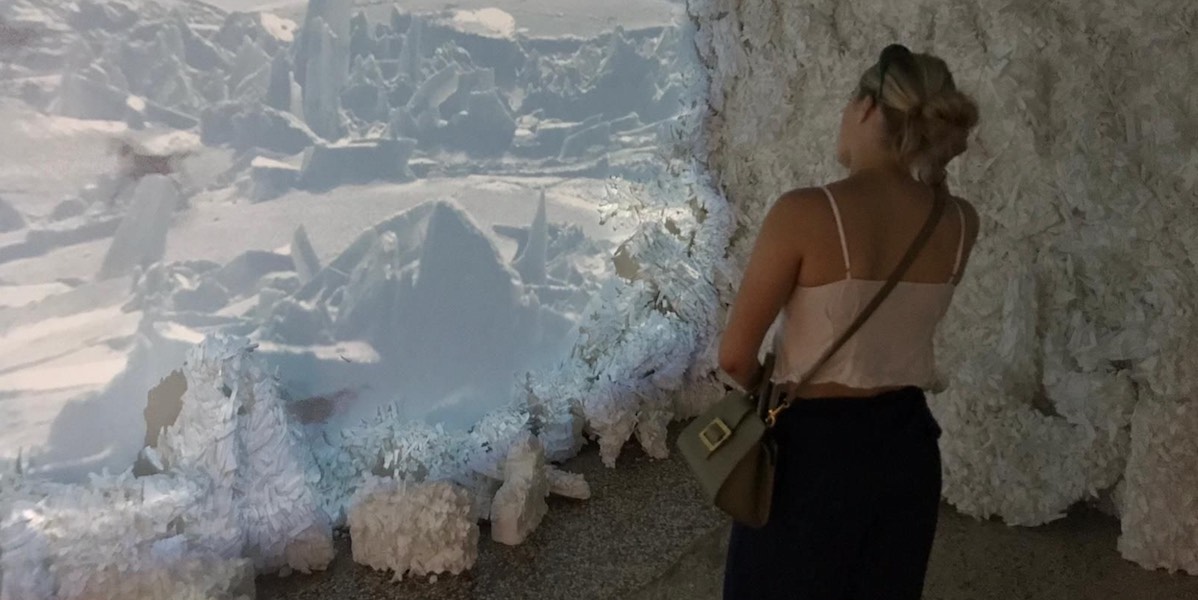The installation of Ronit Keret Tears, presented at the Palazzo Mora in Venice until the end of November, is a striking example of how an artist can contribute to our understanding of a significant scientific problem.
I believe artists have a unique skill to make us see and apprehend, through a visual language, the world around us, the challenges we face, and the significant issues humankind is dealing with. They do this by translating a scientific problem into an Art installation.
Obviously, the climate crisis is one of the most prevalent problems we humans have to address. As a result, more and more artists are now expressing these concerns in artworks, paintings, sculptures, and installations.
In 2018, Tomas Saraceno’s exhibition at Palais de Tokyo offered an alternative to the Anthropocene model – the aerocence, which was an art installation that was able to fly without fossil fuels.
In Ronit Keret’s installation, she raises our awareness of how to address man’s destructive impact on nature. Global warming is at the heart of Keret’s concerns, as Vera Pilpoul, the curator from Tel Aviv, explained when we met in Venice early in May when the exhibition opened.
Ronit Keret was born in Jerusalem. She currently lives in Haifa and graduated from the Midrasha School of Art at Beit Berl Academic College. For the past 11 years, she has been working with Styrofoam, using it for the first time in 2011 for an installation called “Forest”. It was a response to the deadliest catastrophe in Israel’s history, which took place in Mt. Carmel, where 44 people died, 20,000 people were evacuated from their homes, and 6,000 acres of forest and brushland were consumed.
“Forest” (2011), together with another installation “, When All Shall End” (2014) and “Tears” (2017–18) on view in Venice during the Biennale, formed three chapters of Keret’s oeuvre, addressing man’s destructive impact on nature and the future of planet earth.
As Ronit states, “A mere 1.5 degrees Celsius separate us from a complete disappearance of the earth’s glaciers, which will lead to the flooding of the globe and the end of life on it, as we know it.”
TEARS is a multi-layered three-dimensional, and large-scale installation depicting an environment of glaciers made from thousands and thousands of little Styrofoam elements by the Israeli artist. The visitor undergoes a total sensory experience thanks to a sound system playing creaking and quiet sounds of breakage—an authentic recording of the glaciers cracking and breaking up.
With a grand and dramatic installation and two videos, the artist addresses man’s destructive impact on nature: melting glaciers at the poles. For years Keret has been collecting styrofoam scraps, packaging tossed in the trash once their original function is over. Using the mundane material in the tradition of Arte Povera, she gives them a new life as part of a spatial sculptural installation.
Ironically, Styrofoam is the emblematic artificial man-made non-biodegradable material. It is anti-sculptural in essence because of its non-elasticity, its tendency to break down into endless parts, and its textural surface. As Keret mentions, “The usage of white Styrofoam creates in my sculptures a stillness and a sense of the sublime as well as movement and possible disintegration at any given moment.” Accumulation is an important element of Keret’s practice: among the influences on her work, she mentions Ferdinand Cheval’s Ideal Palace (Le Palais idéal).
The white-monochromatic installation creates a space of beauty and spirituality where everyone can reflect and meditate. Here the white colour carries symbolic value as the colour of purity in Western culture and the colour of mourning in Eastern countries.
Overall, there is a sense of ephemerality and fragility in TEARS, yet it is utterly poetic.
Words and Photos: Virginie Puertolas-Syn ©Artlyst 2022
Ronit Keret’s exhibition is part of the international group exhibition “personal structures” that spans both Palazzo Mora & Bembo in Venice until the 27th of November.

